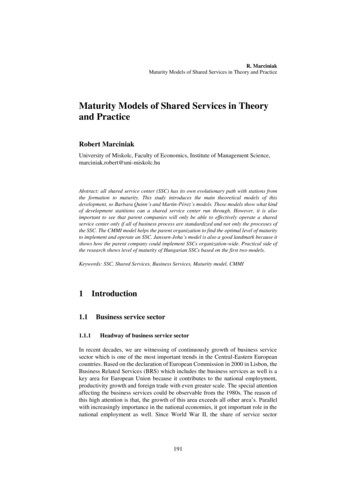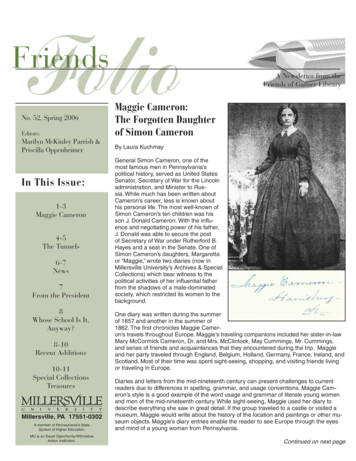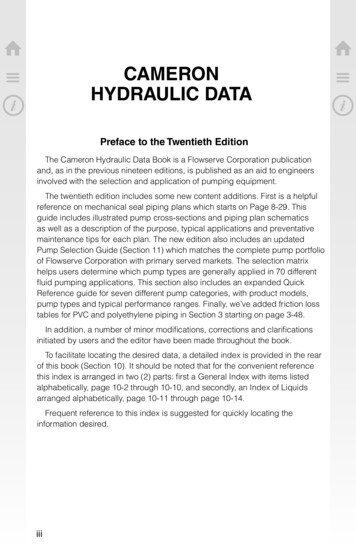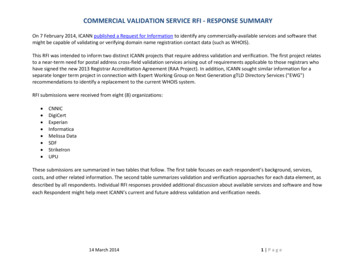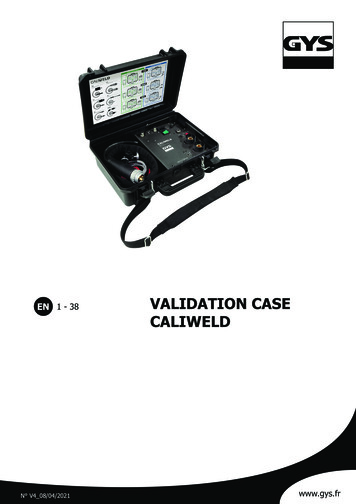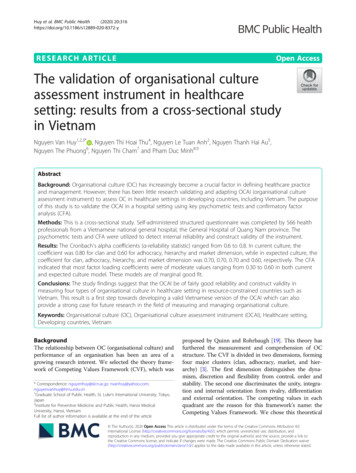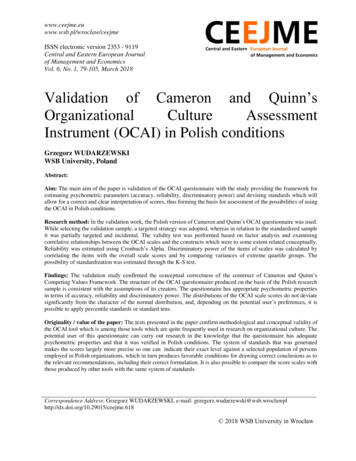
Transcription
www.ceejme.euwww.wsb.pl/wroclaw/ceejmeISSN electronic version 2353 - 9119Central and Eastern European Journalof Management and EconomicsVol. 6, No. 1, 79-105, March 2018Validation of Cameron and Quinn’sOrganizationalCultureAssessmentInstrument (OCAI) in Polish conditionsGrzegorz WUDARZEWSKIWSB University, PolandAbstract:Aim: The main aim of the paper is validation of the OCAI questionnaire with the study providing the framework forestimating psychometric parameters (accuracy, reliability, discriminatory power) and devising standards which willallow for a correct and clear interpretation of scores, thus forming the basis for assessment of the possibilities of usingthe OCAI in Polish conditions.Research method: In the validation work, the Polish version of Cameron and Quinn’s OCAI questionnaire was used.While selecting the validation sample, a targeted strategy was adopted, whereas in relation to the standardized sampleit was partially targeted and incidental. The validity test was performed based on factor analysis and examiningcorrelative relationships between the OCAI scales and the constructs which were to some extent related conceptually.Reliability was estimated using Cronbach’s Alpha. Discriminatory power of the items of scales was calculated bycorrelating the items with the overall scale scores and by comparing variances of extreme quartile groups. Thepossibility of standardization was estimated through the K-S test.Findings: The validation study confirmed the conceptual correctness of the construct of Cameron and Quinn’sCompeting Values Framework. The structure of the OCAI questionnaire produced on the basis of the Polish researchsample is consistent with the assumptions of its creators. The questionnaire has appropriate psychometric propertiesin terms of accuracy, reliability and discriminatory power. The distributions of the OCAI scale scores do not deviatesignificantly from the character of the normal distribution, and, depending on the potential user’s preferences, it ispossible to apply percentile standards or standard tens.Originality / value of the paper: The tests presented in the paper confirm methodological and conceptual validity ofthe OCAI tool which is among those tools which are quite frequently used in research on organizational culture. Thepotential user of this questionnaire can carry out research in the knowledge that the questionnaire has adequatepsychometric properties and that it was verified in Polish conditions. The system of standards that was generatedmakes the scores largely more precise so one can indicate their exact level against a selected population of personsemployed in Polish organizations, which in turn produces favorable conditions for drawing correct conclusions as tothe relevant recommendations, including their correct formulation. It is also possible to compare the score scales withthose produced by other tools with the same system of standards.Correspondence Address: Grzegorz WUDARZEWSKI, e-mail: g/10.29015/ceejme.618 2018 WSB University in Wrocław
VALIDATION OF CAMERON AND QUINN’S ORGANIZATIONAL CULTUREASSESSMENT INSTRUMENT (OCAI) IN POLISH CONDITIONSImplications of the research: The psychometric verification of the OCAI questionnaire produces a range ofpossibilities for the research centered on the issues surrounding organizational culture because the research draws onthe knowledge that it can be conducted employing a tool that was tested and proved useful also in Polish conditions.Members of the contemporary research community want increasingly more often to carry out studies using tools thathave been objectively and quantitatively justified. In the long run, the OCAI can be employed to identify causalrelationships between the phenomena of organizational culture and the factors that are interdependent with this culture,such as management styles or motivational psychological aspects.Limitations of the research: Although the validation study was conducted with differentiated samples, they did notfulfill the requirement of full representativeness for the entire Polish population, which means that the conclusionsdrawn by a potential user of the validated version of the OCAI should be marked by a cautious and balanced approach.The validation works on the questionnaire are still preliminary and they will require to be confirmed by furtherresearch. The percentile and ten standards generated are temporary and general in their nature. Moreover, thesignificance of differences has not been explored between the individual subgroups of the research sample and in thefuture what will be necessary is a statistical verification in the context of creating separate standards depending onsuch variables as type of work, level or industry within which organization functions.Keywords: Organizational culture; Competing Values Framework; OCAI questionnaire; validation.JEL: M12, M51, M521.IndroductionIn the area of globalization, integration and migration of population of today’s Europe the interesttaken in the human factor is of key importance in the context of efficiency and predictability ofresources of an organization. Although it has been almost 30 years since Poland’s politicaltransformation, with domestic scientific achievements being enhanced by a considerable numberof new foreign solutions, methods and tools, knowledge on human functioning in workenvironment continues to appear limited and if explored, then only to a small degree. While ownersor heads of organizations have certain possibilities of exerting influence on how the workenvironment and work conditions are shaped, what still remains important, while being littlecontrollable, is the issue of how employees perceive events and phenomena unfolding in firms, aswell as how individual work situations are interpreted and what meanings are attached to them.One of the crucial parameters, which are also difficult to measure, characterizing the qualitiesof organizational environment is the identification of organizational culture located in indirect andintermediate surrounding environment, as well as within the institution itself. Managingorganizational culture seems to be characterized by strong limitations as many factors contributingto the creation of this phenomenon are located beyond the very organization and the influence ofpeople who manage it. This, however, does not limit the possibilities of identifying the type andcharacteristics of organizational culture within which framework a particular firm functions. To80
Grzegorz WUDARZEWSKIthis end, various proposals, models and tools are used, but only some of them are subject to indepth validity tests and have adequate psychometric parameters. Employing proven diagnostictools for identifying the properties of work environment allows sound and reliable conclusions tobe produced by scientific research, while practitioners can formulate accurate recommendationsand strategies for changes.The object of the paper is validation of one of the most frequently used tool by the researchcommunity, which is the OCAI developed by Cameron and Quinn based on the concept ofCompeting Values Framework, with the tool being employed for identifying the types oforganizational culture. Furthermore, the paper considers the possibilities of using the tool in Polishconditions as an instrument equipped with adequate psychometric parameters.2. Essential features of the Competing Values Framework and the OCAIThe OCAI questionnaire was devised by American scholars Cameron and Quinn who defineorganizational culture as a set of specific organizational values, which are taken for granted,underlying assumptions not necessarily communicated verbally, as well as shared interpretations,expectations and memories of situational factors [Cameron K., Quinn R., 2015, pp. 23-26]. Amongthe roles played by organizational culture, the researchers indicate the following: to systematizeand further specify prevailing views, sustain the stability of the social system and to identifyguidelines for behavior which function in an organization although people are not aware of them.What informs the theoretical assumptions of the OCAI questionnaire is the Competing ValuesFramework proposed by the cited authors. According to this framework, there are two keydimensions at opposing extremes in the organizational environment: 1) flexibility and discretionvs. stability and control; 2) internal focus and integration vs. external focus and differentiation. Therelationship between these dimensions is competitive and conceptually conflicting. The outcomeof the interactions between these two dimensions is the process which gives rise to the followingfour potential types of organizational cultures: clan, adhocracy, market and hierarchy. Cameronand Quinn emphasize that the scores of the OCAI scales for those individual types may be at verydifferentiated but also at very similar levels, which means that it is not always possible to identify81
VALIDATION OF CAMERON AND QUINN’S ORGANIZATIONAL CULTUREASSESSMENT INSTRUMENT (OCAI) IN POLISH CONDITIONSa dominant type of organizational culture. A brief characteristic of those cultures is included inTable 1.1THE CLAN CULTURETHE ADHOCRACY CULTURESTABILITY AND CONTROLTHE MARKET CULTURETHE HIERARCHY CULTUREEXTERNAL FOCUS ANDDIFFERENTIATIONINTERNAL FOCUS ANDINTEGRATIONFLEXIBILITY AND DISCRETIONFigure 1. Competing Values FrameworkSource: Cameron K., Quinn R., 2015, p. 40Table 1. Characteristics of organizational cultures according to Cameron and Quinn’sconceptType cs of organizational culture THEADHOCRACYCULTURE 1It is similar to a family-type organization in which people live and function like in aharmonious familyIt is centered around emotional ties, friendly work atmosphere, shared values andgoalsA high level of work participativeness, a sense of community and cohesionLeaders delegate powers, encourage to participativeness, commitment and loyalty.They play the role of advisors and mentors who are concerned about people and theirneeds, they ensure there is a sense of trust and high moraleTeamwork, commitment and employees’ sense of responsibility for the organization’sfuture.Priorities: partially independent work teams, with team outcomes being favored overindividual achievementsThe organization’s cohesion is ensured by loyalty, tradition, respect, strong ties.Emphasis put on innovation in an era of information and unpredictable changingconditionsIt is centered around task teams that are ad hoc appointed and dynamic which aredisbanded after the task has been accomplishedEmphasis on creating visions of the future, taming anarchy and imagination that isgiven free rein but still disciplinedLeader should be a visionary, innovator and risk taker. There is no centralized powernor authority-based relationships. Power is transferred depending on what is currentlybeing worked on.Detailed information of the Competing Values Framework, the OCAI tool and the interpretation of the four type ofcultures can be found in Cameron and Quinn’s publication cited in the references.82
Grzegorz WUDARZEWSKI THE MARKETCULTURE THEHIERARCHYCULTURE The following is pronounced: adaptability, creativity, non-stereotyped solutions,calculated riskPriorities: flexibility, development of products and services, anticipating the future,entrepreneurship, creativity, quest for innovative solutionsSuccess is associated with being able to create unique and revolutionary products andservicesOrganization operates as a “market”, strong external focusIt is centered around results, profit and task implementationLeaders are hard drivers, ruthless and demanding. They encourage the staff toaggressive competitionEmployees are ambitious, success orientedWhat is pronounced is the leader position and defeating competitionPriorities: winning by the factor that glues the firm, success is associated with themarket share and market penetrationThe organization’s market success need not go hand in hand with social, humanisticsuccess, and a team that is integrated and marked by mutual trust. Demonstrations ofpredatory characteristics and ruthlessness are possible, which may undermine theimage as a trustworthy and credible organizationThe organization perceives the surrounding environment as hostile, consumers asdemanding and fastidious while maintaining its market position as a key elementHighly formalized and hierarchically structuredEmphasis on functioning according to job description, organizational rules and strictinstructions for work processesLeaders make decisions and consider options in terms of how to act, options for workbehaviors are minimalA model leader is a coordinator and organizer who is efficiency-orientedA pronounced role of decision-making centers, centralized decisions, standards,procedures, mechanisms for accounting for results is perceived as a key to successPriorities: a smooth-running organization, stability, productivity, no work distortions,predictability, clinging to rules rigidlyUnpredictable, risky and competitive market can destroy the fixed scenarios, breakthe rules and thus lead to failureSource: Cameron K., Quinn R., 2015, pp. 41-49.The OCAI questionnaire developed by Cameron and Quinn is aimed at identifying the levelsof the types of different organizational cultures, or, if possible, the dominant type for a giveninstitution. The tool is composed of 6 separate parts encompassing 4 items each over which therespondent is to divide an equal sum of 100 points for each part. The next step involves averagingthe total scores for the 6 items for each type of the culture and present them in a graph. Although,as Cameron and Quinn assure, the tool has been verified numerous times for psychometricparameters, there is still not much information on specific validation and psychometric data. Nor83
VALIDATION OF CAMERON AND QUINN’S ORGANIZATIONAL CULTUREASSESSMENT INSTRUMENT (OCAI) IN POLISH CONDITIONShas the author of the present paper found information in the Polish scientific output on validationof the OCAI tool. Annex 1 contains the Polish version of the analyzed questionnaire.3. Characteristics of validation sample and standardization sampleThe considerations presented in this paper are concerned with the in-depth studies carried out bythe author throughout the years 2014-2017 on the issues centered around organizational climate,organizational culture and factors influencing these phenomena. Some of those studies weredevoted to diagnosing new or already created tools which, however, had not been verified in termsof psychometric qualities. Total research samples were quite large and, depending on the specificityand the scope of the analyses to be conducted, encompassed several hundred to several thousandrespondents. For the studies on organizational culture, the author also included (apart from theresults elicited which were used in validation procedures) overall results (scores for the scales ofthe organizational culture types) produced by other researchers or made available by persons fromvarious organizations under the confidentiality clause and on condition of not revealing informationas to where those results had been generated.The sample involved in the validation study of tools for measuring the types oforganizational cultures was targeted and consisted of 320 respondents. On the one hand, the authorwas set on having an adequate number of respondents and, on the other, on having the group to bediagnosed relatively differentiated. What was followed in this respect was the concept of sampleselection developed earlier by the author within the framework of extended validation andempirical studies on organizational climate (see and cf. Wudarzewski G., 2014). In the Polishpractice, conducting a survey with fully representative samples is hampered because of theconsiderable limitations in terms of having the same opportunity of reaching all participants of thepopulation. It is not seldom that even institutions specialized in designing psychometric tools suchas Psychological Tests Laboratory do not carry out research with fully representative samples butonly with selected groups evincing adequate proportions, with the character of the samples beingtargeted or incidental (see and cf. Wudarzewski G., Wudarzewski W., 2017 and literature indicatedtherein). In terms of the size of samples in validation studies, the views tend to vary; however, thepractice and experiences of the author as well as other researchers show that groups of about 300respondents can produce relatively reliable psychometric information (see and cf. WudarzewskiG., 2014). While differentiating the validation sample, it is important to consider demographic84
Grzegorz WUDARZEWSKIdifferences (e.g. gender, age, place of residence) and to carry out the survey employing a varietyof perspectives. Another significant factor when selecting the sample was the author’s intention ofcomparing the elicited results with those produced by the earlier research, which is why it wasdecided to adopt a targeted strategy when selecting the validation sample (informed, quantitativesearch for an adequate number of respondents with specific demographic variables). Given thelimitations in terms of access to the entire population, employees from the following provinceswere taken into account: Lower Silesia, Śląskie Province, Opolskie Province and WielkopolskieProvince. The basic requirement for being included in the sample was that respondents wereemployed either on a permanent or casual basis. The structure of the validation sample is presentedin Table 2.Table 2. Characteristics and the structure of the validation sampleSamplestructure bygenderwomen:N 180Sample structure byageSample structure bythe type of workyouth (age 17-19): N 12students (aged 20-24):N 19Manual-contractingwork :N 45employees (age 25-34):N 110employees (age 35-44):N 141Work involved intrade, sales andcustomer service:N 130employees (age 45-54):N 20Office work,economic andadministrative work:N 115Samplestructure bythe level inorganizationEmployees:N 190Samplestructure byemployment inprovinceLower SilesianProvince:N 185men: N 140employees (age 55-60):N 10employees (over 60 yearsold):Engineeringtechnical work:N 30WielkopolskieProvince:N 30Executives ofmedium andlower levelsN 70ŚląskieProvince:High levelexecutives andowners:OpolskieProvince:N 55N 50N 60N 8Source: self-reported data.85
VALIDATION OF CAMERON AND QUINN’S ORGANIZATIONAL CULTUREASSESSMENT INSTRUMENT (OCAI) IN POLISH CONDITIONSA slightly different, although similar, characteristics showed the standardization sample ofN 933, providing basis for generating standards so as to be able to convert and interpret the scoreselicited by the OCAI users. Here, the author used the scores produced by the studies conducted byother people. The key role in the standardization study was played not so much by the detailedscores elicited from the OCAI questionnaires and from the answers given to specific items, as bythe overall scores calculated for the scales-types of cultures stemming from Cameron and Quinn’sconcept. To this end, the available contacts with other researchers, managers and operational stafffrom organizations located across different provinces were used, and thus the selection strategy forthe standardization sample was in its nature partially targeted and incidental. While transferringthe scores produced through the OCAI measurements, only the overall scale scores were, bydefinition, included, since the author did not have detailed answers in an electronic form andbecause of the already mentioned confidence clause under which it was not permitted to transferinformation on where those scores were generated (employees of various organizations did notgive their consent to make publicly available detailed answers or the name of the institution).Approximate timeframe for the OCAI measurements used in the standardization process coveredthe years 2010 -2017. The detailed structure of the sample used for standardization is presented inTable 3 below.Table 3. Characteristics and the structure of the standardization sampleSample structure bygenderwomen: N 460Sample structure by ageSample structure bythe level inorganizationemployees (age 17-40):N 547Employees:N 540Sample structure byemployment inprovinceLower SilesianProvince:N 423Śląskie Province:N 154employees (age 41-50):N 310Opolskie Province:N 10586
Grzegorz WUDARZEWSKInem: N 473WielkopolskieProvince:N 77Executives ofmedium and lowerlevels:N 223employess (over 50 yearsold): N 76Małopolskie Province:N 56Mazowieckie Province:N 48High level executivesand owners N 170Kujawsko-PomorskieProvince:N 31Łódzkie Province:N 39Source: self-reported data.The sample of the smallest size of N 137 was involved in multifaceted and in-depth studieswithin the framework of which the same respondents were diagnosed concurrently by using severaltools as to how they assessed the different types of organizational cultures and the phenomena thatwere partially related such as: job satisfaction, organizational climate, pathological phenomena ormobbing in workplace. The author conducted the survey on employees of Lower Silesianorganizations mainly on the basis of their availability.4. Validity analysis of the OCAIThe first validity calculations on the OCAI referred to the verification of the questionnairestructure, of exploratory analysis and internal validity. To this end, factor analysis and Varimaxrotation were used. In validation studies, this procedure is relatively frequently employed; however,the identification of the type of organizational culture through the OCAI is quite particular in thatfilling in the questionnaire by respondents consists in dependent estimation (division of 100 pointsper 4 possible answers), which means that while giving points to one answer, one “takes away” thepotential points from the other answers. This, in turn, is not irrelevant for the results produced bythe factor analysis. The major questions in this situation were concerned with the following issues:87
VALIDATION OF CAMERON AND QUINN’S ORGANIZATIONAL CULTUREASSESSMENT INSTRUMENT (OCAI) IN POLISH CONDITIONSwhich parameters (scales-types of cultures) will be compared with each other, in whatconfiguration will they be compared and how many factors would automatically be isolated on thebasis of the validation sample results? The first validity calculations were conducted for the OCAIscores at the level of scales using Varimax rotation. Detailed scores are presented in Table 4 below:Table 4. Factor analysis results estimated at the OCAI scale-level with Varimax rotationOCAI scales considered in the studyFactor 1Factor 2The CLAN CULTURE scale0,7940,265The ADHOCRACY CULTURE scale0,2130,767The MARKET CULTURE scale-0,9480,104The HIERARCHY CULTURE scale0,069-0,950Response variance1,5791,574Share in variance0,3940,393Source: self-reported data using Statistica program (version 12).The factor analysis distinguished two areas within which relatively strong factor loadingsoccurred with the direction contributing to the factor (positive loading) and the direction weakeningthe factor (negative loading). The above results largely confirm the theoretical premises ofCameron and Quinn’s Framework of Competing Values, where the first major dimension“flexibility, internal focus and integration vs. stability, external focus and differentiation” takesinto account the scales at extreme opposites: the clan culture and the market culture; and the seconddimension “flexibility, internal focus and differentiation vs. stability, internal focus andintegration” encompassing at its opposites the adhocracy culture and the hierarchy culture. Thesetwo comparisons of the types of cultures as belonging to one dimension while being at the sametime mutually opposite are in line with the general OCAI concept – the factor analysis comparedwith one another the opposing results for those types of cultures which, according to Cameron andQuinn’s concept, were to be at the opposing extremes.The validity test showed quite clearly a 2-factor structure of the OCAI tool and it was forthis structure that a detailed factor analysis with Varimax rotation was carried out at the level ofitems of the questionnaire validated. Detailed results of the study are contained in Table 5.88
Grzegorz WUDARZEWSKITable 5. The factor analysis results estimated at the level of the OCAI items with VarimaxrotationOCAI scales considered in the studyFactor 1Factor 2Item 1a – CLAN CULTURE scale0,1360,554Item 1b - CLAN CULTURE scale0,1340,585Item 1c - CLAN CULTURE scale0,1140,579Item 1d - CLAN CULTURE scale U0,1570,694Item 1e - CLAN CULTURE scale0,2130,653Item 1f - CLAN CULTURE scale0,1630,699Item 2a – ADHOCRACY CULTURE scale0,6600,181Item 2b - ADHOCRACY CULTURE scale0,6420,021Item 2c - ADHOCRACY CULTURE scale0,5970,015Item 2d - ADHOCRACY CULTURE scale0,7000,225Item 2e - ADHOCRACY CULTURE scale0,7090,120Item 2f - ADHOCRACY CULTURE scale0,6300,117Item 3a – MARKET CULTURE scale0,021-0,476Item 3b - MARKET CULTURE scale-0,233-0,687Item 3c - MARKET CULTURE scale0,054-0,714Item 3d - MARKET CULTURE scale0,157-0,680Item 3e - MARKET CULTURE scale0,055-0,695Item 3f - MARKET CULTURE scale0,125-0,567Item 4a – HIERARCHY CULTURE scale-0,545-0,131Item 4b - HIERARCHY CULTURE scale-0,3300,221Item 4c - HIERARCHY CULTURE scale-0,6530,152Item 4d - HIERARCHY CULTURE scale-0,746-0,096Item 4e - HIERARCHY CULTURE scale-0,7130,108Item 4f - HIERARCHY CULTURE scale-0,615-0,045Response variance5,1265,086Share in variance0,2130,211Source: self-reported data using Statistica program (version 12).The results above show the loading force of the individual OCAI items and provide further detailson the previous analysis. Most of the factor loadings are above average or high in the desiredarrangement of relationships, with those results being linked to relatively low impact indicators inundesired arrangements. According to the results, the study on internal validity of the OCAI89
VALIDATION OF CAMERON AND QUINN’S ORGANIZATIONAL CULTUREASSESSMENT INSTRUMENT (OCAI) IN POLISH CONDITIONSquestionnaire confirms the theoretical premises of the Framework of Competing Values and showsrelatively adequate psychometric qualities in terms of the validated tool.The second method for estimating validity of the OCAI questionnaire was the analysis ofconceptually convergent and discriminant validity, as a concurrent measurement was conductedwith a separate sample of 137 employees of Lower Silesian organizations employing the OCAIquestionnaire together with such tools as MSQ, WIPKO, OCE, R&B, NAQ, ORM2, and anothertool for measuring organizational culture designed by Harrison and Handy. The tools mentionedare used for measuring, respectively: job satisfaction, organizational climate, the incidence ofnegative phenomena and mobbing risk, as well as to define the type of organizational culture(power, role, task, person culture). Each of these areas is partially related to the OCAI types ofcultures; however, these are not the same constructs, and that was the purpose of the correlativeverification. The diagnosis of the above mentioned phenomena was carried out over the period ofconsecutive days with a distance of two weeks in between – the author’s assumption while carryingout the study was to do it within a possibly short timeframe so as to ensure the similarity of theorganizational situations and circumstances. Detailed scores of the correlation between thoseparameters are presented in Tables 6 and 7.OCAI scalesCLAN CULTUREMSQWIPKOOCER&BNAQORMTable 6. r-Pearson’s correlation results between the OCAI scale scores and selectedorganizational phenomena0,3550,2180,3420,402-0,524-0,346ADHOCRACY CULTURE0,113*0,1780,102*0,215-0,137*-0,282MARKET CULURE-0,200-0,169-0,318-0,2810,3990,286HIERARCHY CULTURE-0,216-0,162*-0,064*-0,2410,1920,220* for p 0,05, other values p 0,05Source: self-reported data using Statistica program (version 12).2Full name of the tools: (Multidimensional Measurement Inventory of Organizational Climate); OrganizationalClimate Exercise; Rosenstiel and Bögel’s Organizational Climate Questionnaire; Negative Act Questionnaire;Mobbing Risk Assessment.90
Grzegorz WUDARZEWSKIOCAI scaleCLAN CULTUREpowerr culturerole cultureTask cultureperson cultureTable 7. r-Pearson’s correlation results between the OCAI scale scores and the scales of thetool by Harrison and Handy-0,482-0,3050,4380,325ADHOCRACY CULTURE-0,363-0,114*0,2810,149*MARKET CULTURE0,3950,163*-0,341-0,182HIERARCHY CULTURE0,258-0,301-0,249-0,216* for p 0,05, other values p 0,05Source: self-reported data using Statistica program (version 12).The study on convergent and discriminant validity confirmed that the scores for OCAI scalesare partially or slightly related to the scores for job satisfaction, the other types of organizationalcultures, organizational climate or negative phenomena and mobbing, although the correlationstrends and directions indicate expected, presumed qualities (e.g. the clan culture is negativelycorrelated with the incidence of negative phenomena, the clan culture is negatively correlated withpower culture, the clan culture is positively correlated with person culture). In the context of thevalidation procedure of the OCAI, there is no risk that this tool is too closely related to the otherproposal of measuring organizational culture by Harrison and Handy, or that it measures directlyother related phenomena such as satisfaction, climate or pathological phenomena. This largelyprovides the basis for arguing that the OCAI scales are in their nature relatively distinguishablecompared to the parameters discussed, although in the future it still might be worth conductingdetailed research on this issue with an extended sample.5. Reliability analysis of the OC
a dominant type of organizational culture. A brief characteristic of those cultures is included in Table 1.1 THE CLAN CULTURE Figure 1. Competing Values Framework Source: Cameron K., Quinn R., 2015, p. 40 Table 1. Characteristics of organizational cultures according to Cameron and Quinn's concept Type of organizational culture
